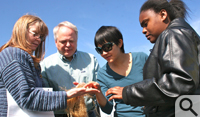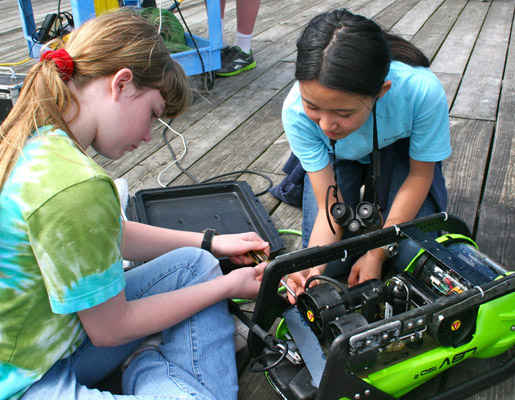Diving into Colonial history
Partnership puts students at the controls of robot submersibles
A partnership between the Virginia Institute of Marine Science and the Watermen’s Museum in historic Yorktown is giving students at three local schools an opportunity to dive into Colonial history—literally.
 This STEM-outreach project, funded by a grant from the
National Science Foundation, allows the students to pilot unmanned submarines
in an attempt to monitor the conservation status of vessels scuttled by Lord
Cornwallis during the Battle of Yorktown in 1781—the last major battle of the
American Revolution.
This STEM-outreach project, funded by a grant from the
National Science Foundation, allows the students to pilot unmanned submarines
in an attempt to monitor the conservation status of vessels scuttled by Lord
Cornwallis during the Battle of Yorktown in 1781—the last major battle of the
American Revolution.
Leading the project are Mark Patterson, head of the Autonomous Systems Laboratory at VIMS, and David Niebuhr, director of the Watermen’s Museum. The students are from Point Option High School in Newport News, the Williamsburg Montessori Middle School and Peasley Middle School in Gloucester. VIMS graduate student Jennifer Elliott, who is teaching at Peasley as part of the VIMS GK-12 partnership, will also be involved.
The project capitalizes on the recent discovery in the York River of two new shipwrecks from the Yorktown battle and siege. Previous archeological work had revealed the presence of nine other wrecks, including HMS Betsy, the target of intensive study during the 1970s and 1980s. These wrecks are listed on the Virginia Landmarks Register and the National Register of Historic Places.
Patterson says the initiative involves middle school and high school students in field robotics at the graduate-student level, while lessons involving archaeology, history, math and marine science “sneak in.” The experiences mix scientific learning with hands-on training and actual operation of two kinds of subs, one that is remotely operated, connected to controls through an umbilical cable and a second sub that is free-swimming, or “autonomous.”
Students run the missions
Since the beginning of 2012, students have been running missions over the shipwrecks from a pier at Yorktown. Patterson says the “real-science” lessons learned include frustrations such as propellers fouled by marine organisms known as hydroids and two instances of props being sheared off by debris—possibly from the wreck itself.
 “The kids are learning lots of interesting skills
including navigation and modular arithmetic, which they need to help collect
valuable data on currents over the wreck site,” Patterson said.
“The kids are learning lots of interesting skills
including navigation and modular arithmetic, which they need to help collect
valuable data on currents over the wreck site,” Patterson said.
The two new York River wrecks were discovered by pioneering marine archeologist John Broadwater—leader of the Betsy study—during a survey done for the Virginia Department of Historic Resources. Patterson also independently discovered one of the sunken vessels during a mission with Fetch I, an autonomous underwater vehicle or AUV developed in his lab. Both explorers made their discoveries using side-scan sonar units manufactured by Marine Sonic Technology of Gloucester. These sonar units can be operated from a boat, or deployed on a robot sub such as Fetch.
The researchers believe the wrecks of the Cornwallis ships were uncovered by strong currents during recent tropical storms. They are concerned that their exposure on the bay floor may lead to rapid degradation. By mapping the wrecks’ outlines, the students will help conservators to monitor their condition and take preventive measures if necessary.
“Enabling students to use advanced robotics at a site of national significance in marine archeology is a first,” says Patterson. “To put these tools into the hands of school kids, to have them monitor shipwrecks that are starting to erode out of the sediment, this is a great way to get them interested in science.”
“These kids are some of the very first people to explore these wrecks, as part of their science classes,” adds Niebuhr, who received his Ph.D. from VIMS in 1999. “They are introduced to real problems—it’s not pretend, it’s genuine. Very rarely are you able to do that in most school programs.”
Combining marine science with history
There’s a lot to learn, so the experience is divided into lessons, each building on the last.
“During the first trip,” says Niebuhr, “we talk about boats, and how they were built in the 18th century. We also learn about the York River ecosystem by conducting simple experiments with currents and turbidity. That helps the students learn that the York is a challenging site for fieldwork, and the difficulties they’ll encounter with both sonar and video imagery if they happen to stir up a bunch of gloop from the bottom.”
During the second lesson, Patterson and Elliott introduce the students to the robots—two Fetch-class AUVs from the Autonomous Systems Lab at VIMS and a VideoRay ROV (remotely operated vehicle) on loan to the Watermen’s Museum from Marine Sonic Technology.
“The Fetch-class subs are equipped with a suite of high-tech sensors,” says Patterson. “The students will learn about side-scan sonar, high-def video, and sensors for measuring water temperature, salinity, chlorophyll, turbidity, dissolved oxygen and pH.”
Finally, the students put their knowledge into action by deploying the VideoRay and one of the Fetch AUVs from a command station adjacent to the Watermen’s pier. The students will re-survey the wrecks on an ongoing basis, and record their condition using side-scan sonar, and when visibility permits, high-definition video.
Analyzing the data
“The students fly the technology and analyze the data,” says Patterson. “In addition to the excitement of working on an actual archeological site, the students will have the opportunity to learn about the marine environment, autonomous underwater vehicles, and the many opportunities for creative problem solving associated with low-visibility, underwater research.”
The Watermen's Museum was founded in 1981 as part of the 200th anniversary of the Battle of Yorktown. Its goal is to recognize the heritage of commercial fishermen and other nautical workers in Chesapeake Bay. The Museum offers numerous hands-on educational activities, including a boat-building program in which local schoolchildren construct historically accurate watercraft using traditional techniques. The Cornwallis project is the museum’s first partnership with VIMS.
For Patterson, the project is the latest in a series of
outreach activities that involve students in marine robotics, including VIMS’
Marine Science Day, the International RoboBoat Competition, Project SeaCAMEL,
and the JASON XI Expedition. He received a "Teaching with Technology"
award from the State Council of Higher Education for Virginia in 2010, for a
"record of superior accomplishment in the use of innovative
educational/instructional technologies" for instruction. ![]()
















